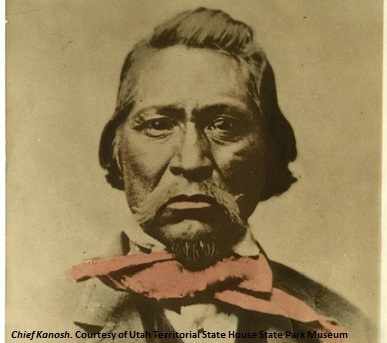Dublin Core
Title
Description
Kanosh, a leader of the Pahvant Utes, used negotiation with white settlers to ensure the survival of his people.
In 1856, Kanosh, an influential leader among central Utah’s Pahvant Utes, delivered a speech before Utah’s territorial legislature. According to Mormon leader Wilford Woodruff, who wrote about the event in his journal, the Pahvant headman affirmed the rightness of the Latter-day Saint cause and defended the abandonment of traditional Ute lifeways in favor of white men’s ways. “I want to plant and raise wheat and learn to plough and do as the white people do,” Woodruff recorded the Pahvant chief as saying.
In the minds of many nineteenth-century Mormons, the speech before the legislature and similar incidents made Kanosh a model Indian. He adopted a lifestyle of sedentary farming and wage work, and according to multiple sources, he had allowed himself to be baptized and ordained an elder by the Mormons. LDS Church members who had moved into Pahvant country referred to him as “Friend of the Whiteman,” perhaps because he seemed so often to back white settlers’ claims to Pahvant land.
To conclude from these details, however, that Kanosh was a puppet of the LDS Church, doesn’t take into account the complexity of human thought and behavior. Kanosh was fully engaged in the maneuverings for power and resources that were sparked by the arrival of the Mormons in the Great Basin and he made conscious choices he believed would benefit himself and his people over the long run. As one historian has explained it, instead of resorting to conflict, Kanosh used negotiation to ensure the survival of his people. It’s debatable, of course, as to how successful that strategy actually was.
Creator
Source
Image: Chief Kanosh, c. 1860-1890s. Portrait of Chief Kanosh, an influential Pavhant Ute leader. Courtesy of Territorial Statehouse State Park Museum
_______________
See Susan Staker, ed., Waiting for World’s End: The Diaries of Wilford Woodruff (Salt Lake City: Signature Books, 1993), 169-170; Clifford Duncan, ”The Northern Utes” in Forrest S. Cuch, ed., A History of Utah’s American Indians (Salt Lake City: Utah State Division of Affairs and the Utah State Historical Society, 2000), 192-193; Virginia McConnell Simmons, The Ute Indians on Utah, Colorado, and New Mexico (Boulder: University Press of Colorado, 2000), 92-108; Martha C. Knack, Boundaries Between: The Southern Paiutes, 1775-1995 (Lincoln: University of Nebraska Press, 2001), 60-61 and 77-78; and Hyrum S. Lewis, “Kanosh and Ute Identity in Territorial Utah,” Utah Historical Quarterly 71 (Fall 2003): 332-347. Also see Paul Padilla’s entry on Kanosh in the online Utah History Encyclopedia

